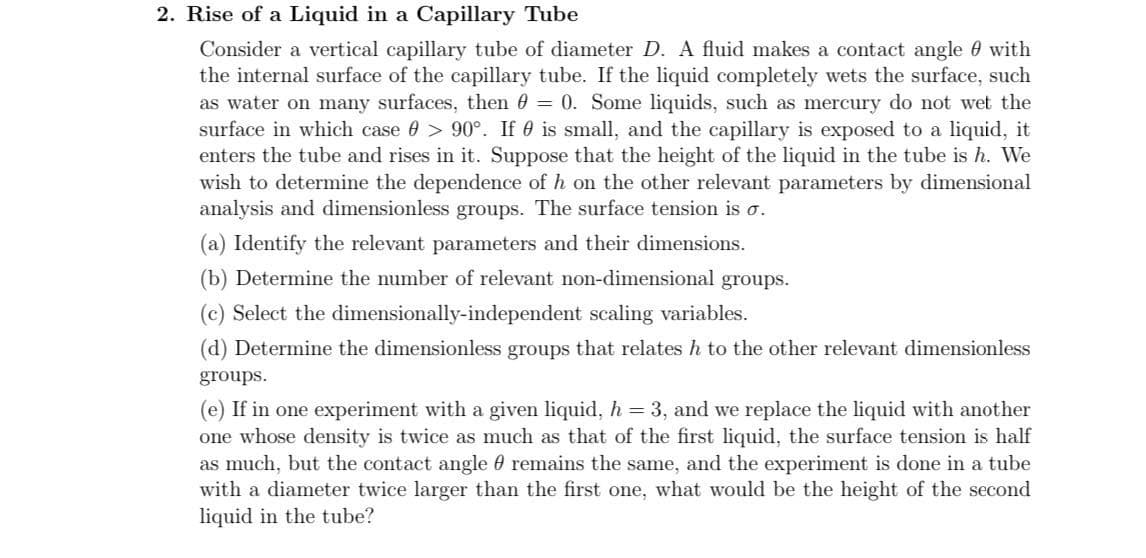2. Rise of a Liquid in a Capillary Tube Consider a vertical capillary tube of diameter D. A fluid makes a contact angle 0 with the internal surface of the capillary tube. If the liquid completely wets the surface, such as water on many surfaces, then 0 = 0. Some liquids, such as mercury do not wet the surface in which case 0 > 90°. If 0 is small, and the capillary is exposed to a liquid, it enters the tube and rises in it. Suppose that the height of the liquid in the tube is h. We wish to determine the dependence of h on the other relevant parameters by dimensional analysis and dimensionless groups. The surface tension is o. %3D (a) Identify the relevant parameters and their dimensions. (b) Determine the number of relevant non-dimensional groups. (c) Select the dimensionally-independent scaling variables. (d) Determine the dimensionless groups that relates h to the other relevant dimensionless groups. (e) If in one experiment with a given liquid, h = 3, and we replace the liquid with another one whose density is twice as much as that of the first liquid, the surface tension is half as much, but the contact angle 0 remains the same, and the experiment is done in a tube with a diameter twice larger than the first one, what would be the height of the second liquid in the tube? %3D
2. Rise of a Liquid in a Capillary Tube Consider a vertical capillary tube of diameter D. A fluid makes a contact angle 0 with the internal surface of the capillary tube. If the liquid completely wets the surface, such as water on many surfaces, then 0 = 0. Some liquids, such as mercury do not wet the surface in which case 0 > 90°. If 0 is small, and the capillary is exposed to a liquid, it enters the tube and rises in it. Suppose that the height of the liquid in the tube is h. We wish to determine the dependence of h on the other relevant parameters by dimensional analysis and dimensionless groups. The surface tension is o. %3D (a) Identify the relevant parameters and their dimensions. (b) Determine the number of relevant non-dimensional groups. (c) Select the dimensionally-independent scaling variables. (d) Determine the dimensionless groups that relates h to the other relevant dimensionless groups. (e) If in one experiment with a given liquid, h = 3, and we replace the liquid with another one whose density is twice as much as that of the first liquid, the surface tension is half as much, but the contact angle 0 remains the same, and the experiment is done in a tube with a diameter twice larger than the first one, what would be the height of the second liquid in the tube? %3D
Related questions
Question

Transcribed Image Text:2. Rise of a Liquid in a Capillary Tube
Consider a vertical capillary tube of diameter D. A fluid makes a contact angle 0 with
the internal surface of the capillary tube. If the liquid completely wets the surface, such
as water on many surfaces, then 0 = 0. Some liquids, such as mercury do not wet the
surface in which case 0 > 90°. If 0 is small, and the capillary is exposed to a liquid, it
enters the tube and rises in it. Suppose that the height of the liquid in the tube is h. We
wish to determine the dependence of h on the other relevant parameters by dimensional
analysis and dimensionless groups. The surface tension is o.
%3D
(a) Identify the relevant parameters and their dimensions.
(b) Determine the number of relevant non-dimensional groups.
(c) Select the dimensionally-independent scaling variables.
(d) Determine the dimensionless groups that relates h to the other relevant dimensionless
groups.
(e) If in one experiment with a given liquid, h = 3, and we replace the liquid with another
one whose density is twice as much as that of the first liquid, the surface tension is half
as much, but the contact angle 0 remains the same, and the experiment is done in a tube
with a diameter twice larger than the first one, what would be the height of the second
liquid in the tube?
%3D
Expert Solution
This question has been solved!
Explore an expertly crafted, step-by-step solution for a thorough understanding of key concepts.
This is a popular solution!
Trending now
This is a popular solution!
Step by step
Solved in 3 steps with 3 images
